Saturday, June 19, 2021
Reprint? Reprint.
In previous item on swamping or flooding I linked back to a semi-related question that I had left open in 2017.
The related question about two-sided scales was actually answered later, but I wasn't thinking about it when I wrote the answer.
Here's the core of the question:
= = = = = START REPRINT 1:
It's easy to measure deltas of order vs chaos in physical objects like houses and paintings, or semiphysical 'performances' like software and music. Is it harder with non-physical things like language and logic?
No, it's not harder.
Some of these are one-sided scales with increases and decreases along one vector; others have opposing vectors with a net resultant.
Language? Two-sided. Making a new and useful word, or a new and useful phrase, is an increase of order and value. Silencing useful words, or swamping useful words with intentionally misleading words, is destruction of value.
Facts? Two-sided. Making a new and valid observation via senses or instruments is an increase of order and value. Silencing a valid fact, or swamping a valid fact with invalid facts, is destruction of value.
= = = = = END REPRINT 1.
The question was answered last year in the topic of Bridges and Balances. I showed how a bridge can measure ORDER VS CHAOS.
= = = = = START REPRINT 2:
Personal Equation Machines calibrate and exercise an astronomer's accuracy and reliability in detecting the truth of a sidereal transit. This is an extremely specialized calibration. Can we find a way to calibrate and train broader powers of truth detection?
If it's possible at all, I think a balance or bridge is a promising path. I'm continuing from last week's discussion of balances and bridges.
= = = = =
I'll use two different types of balance or bridge to show how a balance can detect dynamic or functional qualities, not just static measurements like weight and resistance. These balances send a signal toward the object being measured, and detect the difference between the sent and received signal. If the object is a faithful reflector or amplifier, the difference can be nulled. If the object introduces its own distortions, the difference can't be nulled.
First: The standing-wave balance, commonly used in acoustics labs, sends a steady sound wave down a tube toward a sample of an unknown substance. By changing the frequency of the wave you can set up a resonance in the tube. If you can achieve a resonance or standing wave, you can measure the difference between incident and reflected waves by measuring the strength at the nodes or low points. A perfect reflection leads to zero pressure at the node points.
 Here we're using a GenRad tuning fork oscillator to drive the speaker, and using a GenRad sound level meter to pick up the resultant sound. The sample goes in the cap at the left end. The microphone has a long probe extending through the speaker into the resonance tube, and the probe can be moved back and forth by pushing the microphone car. (Incidentally, the car is sort of fun to 'drive', and can be controlled vernierly with the big wheels.)
Here we're using a GenRad tuning fork oscillator to drive the speaker, and using a GenRad sound level meter to pick up the resultant sound. The sample goes in the cap at the left end. The microphone has a long probe extending through the speaker into the resonance tube, and the probe can be moved back and forth by pushing the microphone car. (Incidentally, the car is sort of fun to 'drive', and can be controlled vernierly with the big wheels.)
 Polistra has opened up the sample cap, and Happystar has a precut sample of an unknown material ready for insertion.
Polistra has opened up the sample cap, and Happystar has a precut sample of an unknown material ready for insertion.
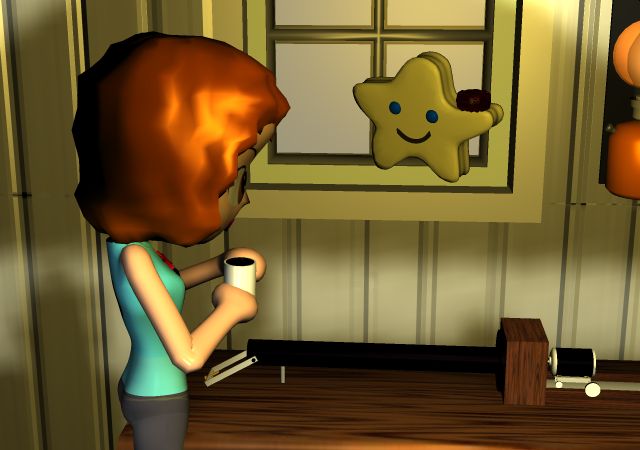 With the oscillator driving the speaker, we can see the green outgoing wave first, then the violet reflected wave by itself, then the interference pattern of the incident and reflected waves. The open end of the microphone probe is roughly centered in the tube. (I've shifted the reflected wave upward for easier visibility.)
With the oscillator driving the speaker, we can see the green outgoing wave first, then the violet reflected wave by itself, then the interference pattern of the incident and reflected waves. The open end of the microphone probe is roughly centered in the tube. (I've shifted the reflected wave upward for easier visibility.)
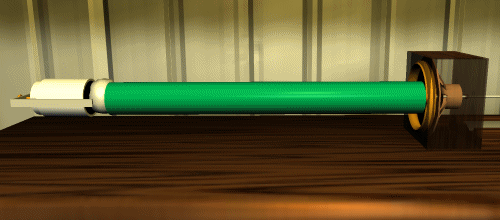 Here's a more schematic image of what really happens. Bear in mind that there's no such thing as zero air pressure. Sound waves are repetitions of increased pressure (red) and decreased pressure (blue) with the "zero" crossings at normal atmospheric pressure. As the incident and reflected waves move through the tube, the actual audible and measurable pressure at each location is always the result of mixing or summing the increased and decreased pressures. The nodes are the places that stay centered as the mix goes up and down.
Here's a more schematic image of what really happens. Bear in mind that there's no such thing as zero air pressure. Sound waves are repetitions of increased pressure (red) and decreased pressure (blue) with the "zero" crossings at normal atmospheric pressure. As the incident and reflected waves move through the tube, the actual audible and measurable pressure at each location is always the result of mixing or summing the increased and decreased pressures. The nodes are the places that stay centered as the mix goes up and down.
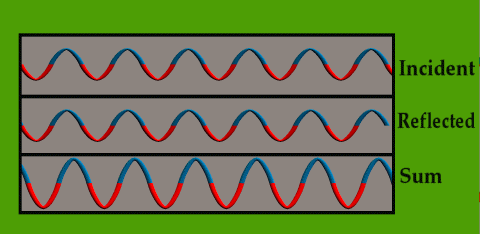 = = = = =
Now we bring in the original question of sensing or measuring faithfulness of reflection. What happens when the material sample distorts the sound instead of just reflecting part of it? Some materials contain a variety of internal resonators that catch certain frequencies and create their own signals in response. Living things do this all the time.
= = = = =
Now we bring in the original question of sensing or measuring faithfulness of reflection. What happens when the material sample distorts the sound instead of just reflecting part of it? Some materials contain a variety of internal resonators that catch certain frequencies and create their own signals in response. Living things do this all the time.
 There's no way to detect a node or null now, because the reflection isn't simply a copy or a negative copy of the original. There might be some points of lower sound, but they will be hard to spot amid the extra frequencies emitted by the active responder.
Several measuring tools for hearing are designed to pick up active live responses. The best is the OAE (oto-acoustic emission) instrument, which I detailed here. The OAE measurement is a truth detector, and is used in real life to detect fake claims of hearing damage.
= = = = =
Second example of a dynamic balance or bridge: an old GenRad tube tester.
There's no way to detect a node or null now, because the reflection isn't simply a copy or a negative copy of the original. There might be some points of lower sound, but they will be hard to spot amid the extra frequencies emitted by the active responder.
Several measuring tools for hearing are designed to pick up active live responses. The best is the OAE (oto-acoustic emission) instrument, which I detailed here. The OAE measurement is a truth detector, and is used in real life to detect fake claims of hearing damage.
= = = = =
Second example of a dynamic balance or bridge: an old GenRad tube tester.
 We have the same basic pieces. A tone generator drives the grid of the tube. When the voltage between the grid and filament of the tube increases, the flow from filament to plate decreases, and thus the voltage in the output loop. Ideally the output loop should provide an amplified reflection of the input loop. The earphones pick up the difference or balance point between the two loops. Adjusting the variable resistor R1 is like adjusting the small weight on a balance, compensating for the amplification.
We have the same basic pieces. A tone generator drives the grid of the tube. When the voltage between the grid and filament of the tube increases, the flow from filament to plate decreases, and thus the voltage in the output loop. Ideally the output loop should provide an amplified reflection of the input loop. The earphones pick up the difference or balance point between the two loops. Adjusting the variable resistor R1 is like adjusting the small weight on a balance, compensating for the amplification.
 Here Polistra is listening for the null while adjusting the resistor to reduce the amplification to equality.
Here Polistra is listening for the null while adjusting the resistor to reduce the amplification to equality.
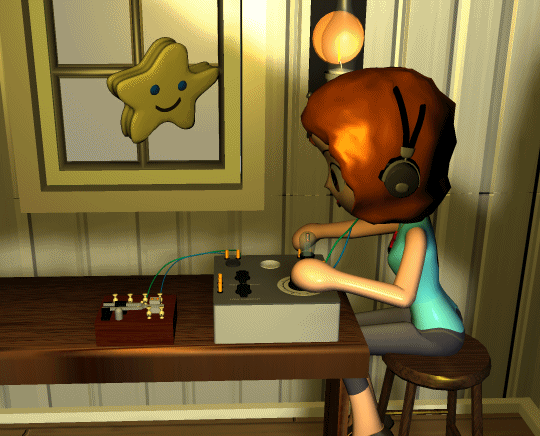 As the pot moves both ways, the reflection in the output loop increases and decreases. At some setting of R1, the reflection will exactly null out the incident signal. If you had to divide the output signal by 4 to hear an exact balance or null, this tells you that the tube was multiplying the input by 4. The setting of R1 thus gives the amplification figure of the tube.
As the pot moves both ways, the reflection in the output loop increases and decreases. At some setting of R1, the reflection will exactly null out the incident signal. If you had to divide the output signal by 4 to hear an exact balance or null, this tells you that the tube was multiplying the input by 4. The setting of R1 thus gives the amplification figure of the tube.
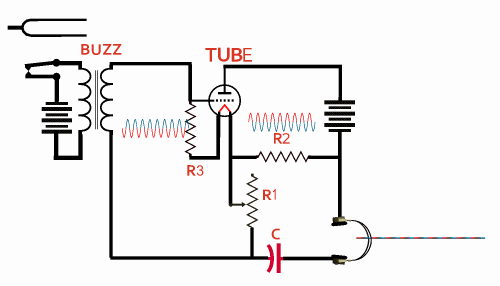 Now we introduce distortion, as we did with the standing-wave acoustic reflection. When the sample being examined (the tube) creates its own noise or active responses, there's no chance of nulling the output. The output loop can never be either a copy or an inverted copy of the input, no matter how much it's reduced by R1. There will always be something extra audible.
Now we introduce distortion, as we did with the standing-wave acoustic reflection. When the sample being examined (the tube) creates its own noise or active responses, there's no chance of nulling the output. The output loop can never be either a copy or an inverted copy of the input, no matter how much it's reduced by R1. There will always be something extra audible.
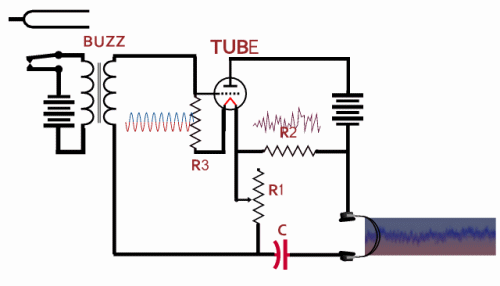 = = = = =
Both of these dynamic or functional balances can perform a service that would be hard to define and measure in a simple balance, though it's actually a common situation with a simple balance. Think of trying to weigh a puppy on a produce scale. You could tell that the animal was restless and wiggling around, but the scale wouldn't be able to measure the restless behavior itself. The wiggling would be an unwanted factor, and you'd have to approximate the mean weight in the middle of the jumping and tail-wagging.
As mentioned at the start, this doesn't reach the ultimate goal of a balance-style truth calibrator or exerciser. The active setting of the microphone car or R1 would be the equivalent of tapping the telegraph key on the Personal Equation Machine. There are several huge missing steps. How would this active setting serve as an exercise to help you USE your detection ability? How would a balance try to null out a more abstract "sample" of a moral question? Is there a more concrete "sample" that will accomplish the same exercise?
= = = = =
= = = = = END REPRINT 2.
= = = = =
Both of these dynamic or functional balances can perform a service that would be hard to define and measure in a simple balance, though it's actually a common situation with a simple balance. Think of trying to weigh a puppy on a produce scale. You could tell that the animal was restless and wiggling around, but the scale wouldn't be able to measure the restless behavior itself. The wiggling would be an unwanted factor, and you'd have to approximate the mean weight in the middle of the jumping and tail-wagging.
As mentioned at the start, this doesn't reach the ultimate goal of a balance-style truth calibrator or exerciser. The active setting of the microphone car or R1 would be the equivalent of tapping the telegraph key on the Personal Equation Machine. There are several huge missing steps. How would this active setting serve as an exercise to help you USE your detection ability? How would a balance try to null out a more abstract "sample" of a moral question? Is there a more concrete "sample" that will accomplish the same exercise?
= = = = =
= = = = = END REPRINT 2.
 Here we're using a GenRad tuning fork oscillator to drive the speaker, and using a GenRad sound level meter to pick up the resultant sound. The sample goes in the cap at the left end. The microphone has a long probe extending through the speaker into the resonance tube, and the probe can be moved back and forth by pushing the microphone car. (Incidentally, the car is sort of fun to 'drive', and can be controlled vernierly with the big wheels.)
Here we're using a GenRad tuning fork oscillator to drive the speaker, and using a GenRad sound level meter to pick up the resultant sound. The sample goes in the cap at the left end. The microphone has a long probe extending through the speaker into the resonance tube, and the probe can be moved back and forth by pushing the microphone car. (Incidentally, the car is sort of fun to 'drive', and can be controlled vernierly with the big wheels.)
 Polistra has opened up the sample cap, and Happystar has a precut sample of an unknown material ready for insertion.
Polistra has opened up the sample cap, and Happystar has a precut sample of an unknown material ready for insertion.
 With the oscillator driving the speaker, we can see the green outgoing wave first, then the violet reflected wave by itself, then the interference pattern of the incident and reflected waves. The open end of the microphone probe is roughly centered in the tube. (I've shifted the reflected wave upward for easier visibility.)
With the oscillator driving the speaker, we can see the green outgoing wave first, then the violet reflected wave by itself, then the interference pattern of the incident and reflected waves. The open end of the microphone probe is roughly centered in the tube. (I've shifted the reflected wave upward for easier visibility.)
 Here's a more schematic image of what really happens. Bear in mind that there's no such thing as zero air pressure. Sound waves are repetitions of increased pressure (red) and decreased pressure (blue) with the "zero" crossings at normal atmospheric pressure. As the incident and reflected waves move through the tube, the actual audible and measurable pressure at each location is always the result of mixing or summing the increased and decreased pressures. The nodes are the places that stay centered as the mix goes up and down.
Here's a more schematic image of what really happens. Bear in mind that there's no such thing as zero air pressure. Sound waves are repetitions of increased pressure (red) and decreased pressure (blue) with the "zero" crossings at normal atmospheric pressure. As the incident and reflected waves move through the tube, the actual audible and measurable pressure at each location is always the result of mixing or summing the increased and decreased pressures. The nodes are the places that stay centered as the mix goes up and down.
 = = = = =
Now we bring in the original question of sensing or measuring faithfulness of reflection. What happens when the material sample distorts the sound instead of just reflecting part of it? Some materials contain a variety of internal resonators that catch certain frequencies and create their own signals in response. Living things do this all the time.
= = = = =
Now we bring in the original question of sensing or measuring faithfulness of reflection. What happens when the material sample distorts the sound instead of just reflecting part of it? Some materials contain a variety of internal resonators that catch certain frequencies and create their own signals in response. Living things do this all the time.
 There's no way to detect a node or null now, because the reflection isn't simply a copy or a negative copy of the original. There might be some points of lower sound, but they will be hard to spot amid the extra frequencies emitted by the active responder.
Several measuring tools for hearing are designed to pick up active live responses. The best is the OAE (oto-acoustic emission) instrument, which I detailed here. The OAE measurement is a truth detector, and is used in real life to detect fake claims of hearing damage.
= = = = =
Second example of a dynamic balance or bridge: an old GenRad tube tester.
There's no way to detect a node or null now, because the reflection isn't simply a copy or a negative copy of the original. There might be some points of lower sound, but they will be hard to spot amid the extra frequencies emitted by the active responder.
Several measuring tools for hearing are designed to pick up active live responses. The best is the OAE (oto-acoustic emission) instrument, which I detailed here. The OAE measurement is a truth detector, and is used in real life to detect fake claims of hearing damage.
= = = = =
Second example of a dynamic balance or bridge: an old GenRad tube tester.
 We have the same basic pieces. A tone generator drives the grid of the tube. When the voltage between the grid and filament of the tube increases, the flow from filament to plate decreases, and thus the voltage in the output loop. Ideally the output loop should provide an amplified reflection of the input loop. The earphones pick up the difference or balance point between the two loops. Adjusting the variable resistor R1 is like adjusting the small weight on a balance, compensating for the amplification.
We have the same basic pieces. A tone generator drives the grid of the tube. When the voltage between the grid and filament of the tube increases, the flow from filament to plate decreases, and thus the voltage in the output loop. Ideally the output loop should provide an amplified reflection of the input loop. The earphones pick up the difference or balance point between the two loops. Adjusting the variable resistor R1 is like adjusting the small weight on a balance, compensating for the amplification.
 Here Polistra is listening for the null while adjusting the resistor to reduce the amplification to equality.
Here Polistra is listening for the null while adjusting the resistor to reduce the amplification to equality.
 As the pot moves both ways, the reflection in the output loop increases and decreases. At some setting of R1, the reflection will exactly null out the incident signal. If you had to divide the output signal by 4 to hear an exact balance or null, this tells you that the tube was multiplying the input by 4. The setting of R1 thus gives the amplification figure of the tube.
As the pot moves both ways, the reflection in the output loop increases and decreases. At some setting of R1, the reflection will exactly null out the incident signal. If you had to divide the output signal by 4 to hear an exact balance or null, this tells you that the tube was multiplying the input by 4. The setting of R1 thus gives the amplification figure of the tube.
 Now we introduce distortion, as we did with the standing-wave acoustic reflection. When the sample being examined (the tube) creates its own noise or active responses, there's no chance of nulling the output. The output loop can never be either a copy or an inverted copy of the input, no matter how much it's reduced by R1. There will always be something extra audible.
Now we introduce distortion, as we did with the standing-wave acoustic reflection. When the sample being examined (the tube) creates its own noise or active responses, there's no chance of nulling the output. The output loop can never be either a copy or an inverted copy of the input, no matter how much it's reduced by R1. There will always be something extra audible.
 = = = = =
Both of these dynamic or functional balances can perform a service that would be hard to define and measure in a simple balance, though it's actually a common situation with a simple balance. Think of trying to weigh a puppy on a produce scale. You could tell that the animal was restless and wiggling around, but the scale wouldn't be able to measure the restless behavior itself. The wiggling would be an unwanted factor, and you'd have to approximate the mean weight in the middle of the jumping and tail-wagging.
As mentioned at the start, this doesn't reach the ultimate goal of a balance-style truth calibrator or exerciser. The active setting of the microphone car or R1 would be the equivalent of tapping the telegraph key on the Personal Equation Machine. There are several huge missing steps. How would this active setting serve as an exercise to help you USE your detection ability? How would a balance try to null out a more abstract "sample" of a moral question? Is there a more concrete "sample" that will accomplish the same exercise?
= = = = =
= = = = = END REPRINT 2.
= = = = =
Both of these dynamic or functional balances can perform a service that would be hard to define and measure in a simple balance, though it's actually a common situation with a simple balance. Think of trying to weigh a puppy on a produce scale. You could tell that the animal was restless and wiggling around, but the scale wouldn't be able to measure the restless behavior itself. The wiggling would be an unwanted factor, and you'd have to approximate the mean weight in the middle of the jumping and tail-wagging.
As mentioned at the start, this doesn't reach the ultimate goal of a balance-style truth calibrator or exerciser. The active setting of the microphone car or R1 would be the equivalent of tapping the telegraph key on the Personal Equation Machine. There are several huge missing steps. How would this active setting serve as an exercise to help you USE your detection ability? How would a balance try to null out a more abstract "sample" of a moral question? Is there a more concrete "sample" that will accomplish the same exercise?
= = = = =
= = = = = END REPRINT 2.
Labels: Asked and answered, Equipoise
